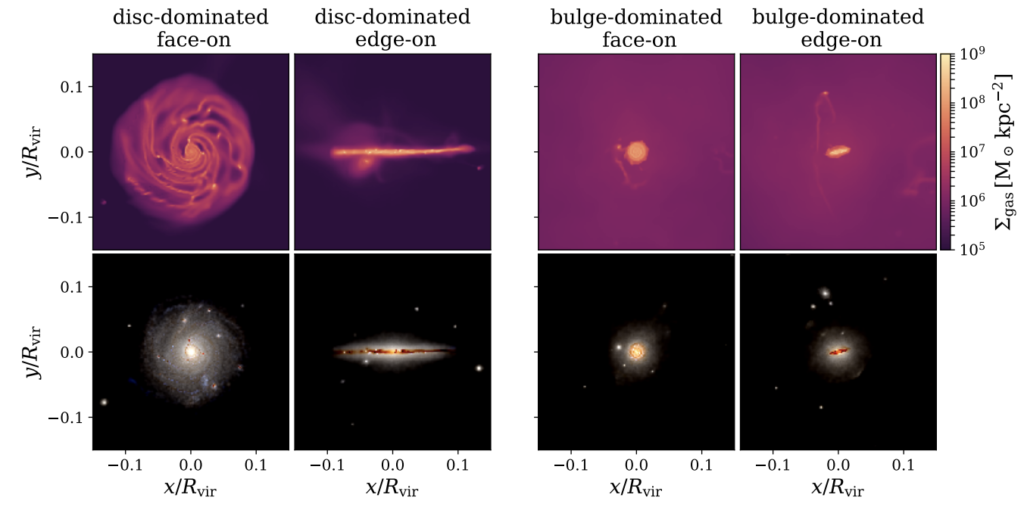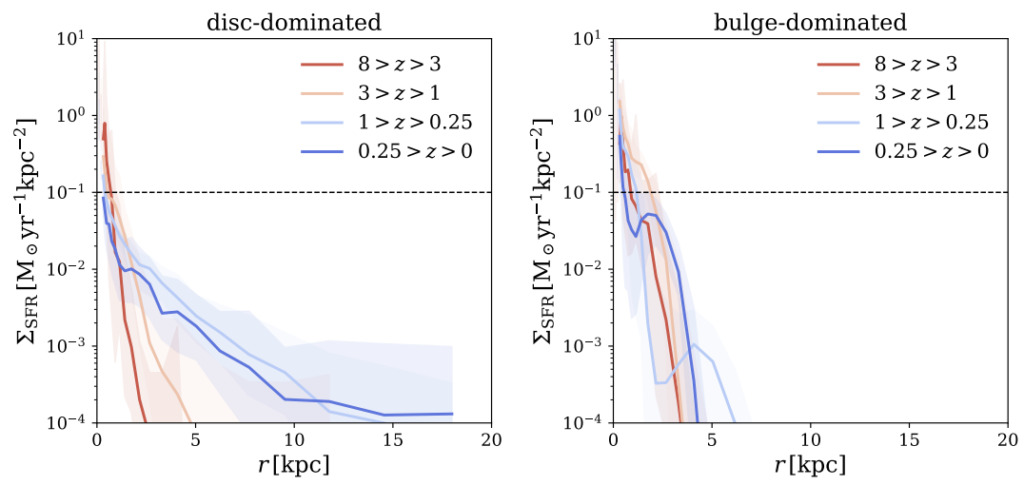Title: The Grand Twirl: The Epoch of Rapid Assembly of Extended and Quiescent Discs
Authors: M. Kretschmer, O. Agertz, & R. Teyssier
First Author’s Institution: Institute for Computational Science, University of Zurich
Status: Submitted to MNRAS, open access on ArXiv
The late eminent astronomer Carl Sagan once quipped “telescopes are time machines”. Indeed, one of the most celebrated milestones since Edwin Hubble’s landmark discovery of the “island universes” in 1924 is the rich collection of billions of galaxies — stretching back some 13 billion years — as revealed in ultra-deep imaging kicked off by the Hubble Space Telescope in 1995 with the spectacular Deep Field. Since then, the universe has successively provided more intriguing puzzles about the formation and evolution of the galaxies.
Within the present study of astrophysics, there is a multitude of questions about how the galaxies we see today came to be. How did galaxies get their stars and gas? How much of the stars and gas are leftover from their formation? How much gas has been accreted from pristine intergalactic molecular gas streams (of the cosmic web), how many stars were formed from this new gas, or from merging with other galaxies? What factors determine how efficiently a galaxy can turn molecular gas into stars? Do galaxies seen today reflect their “assembly history”, and could this explain the observed bimodality of blue star-forming spiral galaxies and red quiescent ellipticals, and the seemingly ubiquitous correlation of their properties?
The past two decades have witnessed phenomenal progress in this area, from the reconstruction of galaxy star-formation histories of observed galaxies to detailed simulations of the formation, growth, and interaction of thousands of galaxies over cosmic time.
Today’s astrobite addresses these questions in the context of a simulation capable of tracking a range of processes including energy injection from supernovae, the angular momentum of the gas and stars, the star-formation rate, outflowing gas, merger history, and even the properties of the parent dark matter halo in which the galaxy resides.
In brief, the authors first ran a dark matter only simulation. Since dark matter only interacts gravitationally, the simulation simply has to follow some initial dark matter halos through time, allowing them to merge. The assumption being that the two galaxies within these halos would likewise merge. Pausing at the present day, two dark matter halos were selected which had similar histories and characteristics. Firstly, they each had a major merger at z~1.7 (~4Gyr after the Big Bang) and no significant mergers after z~1. Secondly, their dark matter halo spins (yes, they spin!) are very similar.
The authors then ran the simulation again, but this time adding in all the astrophysical ingredients to provide the gas and stars to both halos. Each galaxy experienced strong bursts of star-formation which drove tremendous outflows of gas before a cataclysmic merger at z~1.7, after which they had no significant starbursts.
No one expected what followed.

As seen in Figure 1, despite similar merger histories, the resulting galaxies are very different. On the left, a typical spiral galaxy with slow and steady star-formation in an extended disc. On the right, a compact bulge-dominated galaxy with meager star-formation.
The reason for this divergence? The galaxies accreted their molecular gas following the merger in different ways, an event poetically dubbed “The Grand Twirl”.
The Grand Twirl started with each post-merger galaxy rapidly growing a molecular gas disc. While the disc-dominated galaxy accretes gas co-rotating with the existing innermost gas, the bulge-dominated galaxy suffers from an accreted counter-rotating gas disc. The effect of this counter-rotation that both the inner and outer gas lose angular momentum and fall inwards, destroying the extended disc structure. Oppositely, the co-rotation of the gas in the disc-dominated galaxy acts constructively to build up the disc. These processes are illustrated in Figure 2.

The consequences of the Grand Twirl are seemingly enormous. The disc-dominated galaxy quickly transitions to an archetypical spiral galaxy like our Milky Way. Meanwhile, the bulge-dominated galaxy is utterly transformed into an elliptical galaxy. It features a small, newly formed nuclear star-forming disc which arose directly from the counter-rotating gas; additional outflows from the nuclear region act to fill the halo to a density 10x that of the halo of the disc-dominated galaxy.
The authors also stress that the prevailing angular momenta of each galaxy are not correlated with the initial (similar) dark matter halo spin, contrary to classical theory. This finding is consistent with those of several other recent studies, adding to the slow erosion of the classical theory of disc growth and mass assembly.
It seems then that post-merger galaxies mature rapidly following their “Grand Twirl”, transitioning from starbursts with supernovae driven outflows at high redshift to calmer giant galaxies in the present epoch, decidedly as either a disc-dominated star-forming spiral or bulge-dominated red quiescent elliptical.
This is tough news to observers, as evidence for such a dynamic event is difficult to confirm from a single snapshot of a galaxy. And yet the Grand Twirl is seemingly crucial to answer these looming questions, making simulations such as these invaluable. While these are only two examples, the authors plan to explore a larger sample size in future work.




